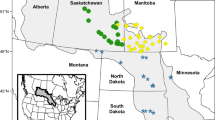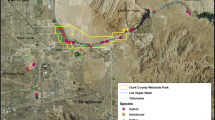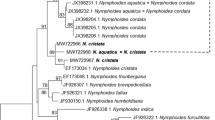Abstract
The recent recognition of invasive hybrid watermilfoil (Myriophyllum spicatum × M. sibiricum) in North America has necessitated a more thorough evaluation of its overall distribution and occurrence in natural populations. A comprehensive survey of watermilfoil populations was conducted in five Minnesota lakes, three of which were suspected a priori to contain hybrid watermilfoil. DNA sequence data verified that hybrid plants between the nonindigenous M. spicatum L. and indigenous M. sibiricum Kom. occurred in three of the five lakes sampled. Myriophyllum spicatum was not detected in lakes where hybrids were prevalent. Further sampling of lakes in Idaho, Michigan, Minnesota, Wisconsin and Washington identified 30 additional hybrid watermilfoil populations. In only three of these populations the hybrid watermilfoil was found to co-occur with M. spicatum. To facilitate the field identification of the two parental species and their hybrid, morphological data from watermilfoil specimens collected across the United States were evaluated. We determined that leaf segment/leaf length measurements can effectively distinguish M. spicatum and M. sibiricum; however, hybrids are intermediate for these characters and such measurements frequently overlap with respect to their parental taxa. By incorporating a combined molecular and morphological approach to identifying watermilfoils, the hybrids can be identified readily and their distributions elucidated both within and between lakes. Because hybrids may respond differently to local ecological conditions than their parents, information on their presence and distribution should be of particular importance to management and conservation programs.




Similar content being viewed by others
References
Aiken SG (1981) A conspectus of Myriophyllum (Haloragaceae) in North America. Brittonia 33:57–69
Aiken SG (1978) [Counts on Haloragaceae] p. 522. In: A. Love, IOPB Chromosome number reports LXII. Taxon 27:519–535
Anderson E (1948) Hybridization of the habitat. Evolution 2:1–9
Bartodziej W, Ludlow L (1998) Aquatic vegetation monitoring by natural resources agencies in the United States. Aquatics 20:15–18
Campbell CS, Wojciechowski MA, Baldwin BG, Alice LA, Donoghue MJ (1997) Persistent nuclear ribosomal DNA sequence polymorphism in the Amelanchier agamic complex. Mol Biol Evol 14:81–90
Creed RP Jr, Sheldon SP (1995) Use of a native insect as a biological control for an introduced weed. Ecol Appl 5:1122–1132
Cronk JK, Fennessy MS (2001) Wetland plants: biology and ecology. Lewis Publishers, Boca Raton, Florida
Cronn R, Cedroni M, Haselkorn T, Grover C, Wendel JF (2002) PCR-mediated recombination in amplification products derived from polyploid cotton. Theor Appl Genet 104:482–489
Crow GE, Hellquist CB (2000) Aquatic and wetland plants of Northeastern North America Vol. 1. The University of Wisconsin Press, Madison, Wisconsin
Doyle JJ, Doyle JL (1987) A rapid DNA isolation procedure for small quantities of fresh leaf tissue. Phytochem Bul Bot Soc Am 19:11–15
Ellstrand NC, Schierenbeck KA (2000) Hybridization as a stimulus for the evolution of invasiveness in plants? Proc Nat Acad Sci USA 97:7043–7050
Emms SK, Arnold ML (1997) The effect of habitat on parental and hybrid fitness: Transplant experiments with Louisiana irises. Evolution 51:1111–1119
Fernald ML (1919) Two new Myriophyllum and a species new to the United States. Rhodora 21:121–124
Figueroa ME, Castillo JM, Redondo S, Luque T, Castellanos EM, Nieva FJ, Luque CJ, Rubio-Casal AE, Davy AJ (2003) Facilitated invasion by hybridization of Sarcocornia species in a salt-marsh succession. J Ecol 91:616–626
Floate KD, Whitham TG (1994) Aphid–ant interaction reduces chrysomelid herbivory in a cottonwood hybrid zone. Oecologia 97:215–221
Fritz RS, Nichols-Orians CM, Brunsfeld SJ (1994) Interspecific hybridization of plants and resistance to herbivores: hypotheses, genetics, and variable responses in adverse herbivore community. Oecologia 97:106–117
Furnier GR, Olfelt JP, Stolz AM (1995) Genetic variation in Eurasian watermilfoil. Report submitted as deliverables C2.4.1 and C3.1.1. Minnesota Department of Natural Resources, Ecological Services, St. Paul, MN
Galatowitsch SM, Anderson NO, Ascher PD (1999) Invasiveness in wetland plants in temperate North America. Wetlands 19:733–755
Hershkovitz MA, Zimmer EA, Hahn WJ (1999) Ribosomal DNA sequences and angiosperm systematics. In: Hollingsworth PM, Bateman RM, Gornall RJ (eds) Molecular systematics and plant evolution. Taylor & Francis, London, UK, pp 268–326
Hughes CE, Bailey CD, Harris SA (2002) Divergent and reticulate species relationships in Leucaena (Fabaceae) inferred from multiple data sources: insights into polyploid origins and nrDNA polymorphism. Am J Bot 89:1057–1073
Jacono CC, Richerson MM (2003) http://nas.er.usgs.gov/taxgroup/plants/docs/my_spica.html
Jester LL, Bozek MA, Helsel DR, Sheldon SP (2000) Euhrychiopsis lecontei distribution abundance and experimental augmentations for Eurasian watermilfoil control in Wisconsin lakes. J Aquat Plant Manag 38:88–97
Kim AS (2005) Milfoil campaign spreading. Portland Press Herald, Monday, February 14, 2005
Love A, Love D (1958) The American element in the flora of the British Isles. Bot Notes 3:373–388
Love A, Ritchie JG (1966) Chromosome numbers from central and northern Canada. Can J Bot 44:429–439
Maddison DR, Maddison WP (2001) MacClade. Analysis of phylogeny and character evolution. 4.01. Sinauer, Sunderland, MA
Moody ML, Les DH (2002) Evidence of hybridity in invasive watermilfoil (Myriophyllum) populations. Proc Nat Acad Sci USA 99:14867–14871
Newman RM (2004) Biological control of Eurasian Watermilfoil completion report for 2001–2004 submitted to the Minnesota Department of Natural Resources. Ecological Services, St. Paul, MN
Newman RM, Borman ME, Castro SW (1997) Developmental performance of the weevil Euhrychiopsis lecontei on native and exotic watermilfoil host plants. J North Am Benthol Soc 16:627–634
Orchard AE (1981) A revision of South American Myriophyllum (Haloragaceae), and its repercussion on some Australian and North American species. Brunonia 4:27–65
Patten BC (1954) The status of some American species of Myriophyllum as revealed by the discovery of intergrade material between M. exalbescens and M. spicatum in New Jersey. Rhodora 56:213–225
Rieseberg LH (2001) Chromosomal rearrangements and speciation. Trends Ecol Evol 16:351–358
Rieseberg LH, Raymond O, Rosenthal DM, Lai Z, Livingstone K, Nakazato T, Durphy JL, Schwarzbach AE, Donovan LA, Lexer C (2003) Major ecological transitions in wild sunflowers facilitated by hybridization. Science 301:1211–1216
Roley SS, Newman RM (2006) Developmental performance of the milfoil weevil, Euhrychiopsis lecontei (Coleoptera: Curculionidae), on northern watermilfoil, Eurasian watermilfoil and hybrid (northern × eurasian) watermilfoil. Environ Entomol 35:121–126
Rogstad SH (1992) Saturated NaCl-CTAB solution as a means of field preservation of leaves for DNA analyses. Taxon 41:701–708
Schwarzbach AE, Donovan LA, Rieseberg LH (2001) Transgressive character expression in a hybrid sunflower species. Am J Bot 88:270–277
Swofford DL (2000) Phylogenetic analysis using parsimony. Version 4.0. Sinauer Associates, Sunderland
Taberlet P, Gielly L, Pautou G, Bouvet J (1991) Universal primers for amplification of three non-coding regions of chloroplast DNA. Plant Mol Biol 17:1105–1109
White TJ, Bruns SL, Taylor J (1990) Amplification and direct sequencing of fungal ribosomal RNA genes for phylogenetics. In: Innis M, Gelfand D, Sninsky J, White TJ (eds) PCR protocols: a guide to methods and applications. Academic Press, San Diego, California, USA, pp 315–322
Whitham TG, Martinsen GD, Floate KD, Dungey HS, Potts BM, Keim P (1999) Plant hybrid zones affect biodiversity: tools for a genetic-based understanding of community structure. Ecology 80:416–428
Acknowledgements
We acknowledge the Department of Natural Resources in Minnesota (esp. Chip Welling), Wisconsin (esp. Laura Herman), and Washington (esp. Jenifer Parsons), and also B. Pullman for their assistance in collecting specimens for this study. Funding for this project has been provided by NEBC Graduate Student Research Award Program, CAWS Michael Lefor Wetland Science Research Grant, Karling Graduate Student Research award (BSA), William R. Anderson Student Research Grant (ASPT), University of Connecticut Bamford Endowment Fund, Minnesota Dept. of Natural Resources and NSF DDIG 0309123.
Author information
Authors and Affiliations
Corresponding author
Rights and permissions
About this article
Cite this article
Moody, M.L., Les, D.H. Geographic distribution and genotypic composition of invasive hybrid watermilfoil (Myriophyllum spicatum × M. sibiricum) populations in North America. Biol Invasions 9, 559–570 (2007). https://doi.org/10.1007/s10530-006-9058-9
Received:
Accepted:
Published:
Issue Date:
DOI: https://doi.org/10.1007/s10530-006-9058-9




